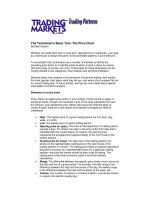Price pattern trading0318
Bạn đang xem bản rút gọn của tài liệu. Xem và tải ngay bản đầy đủ của tài liệu tại đây (2.02 MB, 59 trang )
Introduction
Trading is hard.
trading is simple.
The act
of
But putting it all together in a consistent manner will take effort,
drive, and success will only come to those who put in the work.
Methods to analyse your charts are also simple but humans enjoy
complexity yet that does not guarantee success.
Common theories such as moving averages act as support and
resistance is flawed. When you start to look at the usual teachings
with a critical eye and ask “why”, the theory starts to unravel and
leaves the trader confused.
Simple works.
I'm not asking you to trust me. I'd
rather you not.
What I am asking is that you approach the information with an open
mind and be critical - prove it to yourself.
You are going to lose.
There is no “sure-fire” trading strategy or system that will let you
book 100% win rates or let you off the hook without a string of
losses.
Your wins and losses will come in a random distribution and your job
is to consistently execute your trading plan and let your edge bring
you back on the right side of the winners circle.
1
You are not going to read about a bunch of indicators and special
settings that will “tip you off” to a winning set of trades.
They don’t exist.
What does exist is how markets have always moved, how traders
behave, and the subtle clues that show up that can point to the
probability of one thing happening over another.
For that reason, there is no table of contents.
Each section builds on the previous section and jumping around will
leave gaps in your understanding and you will not get the full value of
what you are reading.
Ready to get started?
2
INTRODUCTION TO PRICE ACTION
Open up any chart and look at what price is doing.
Is it going up? Going down? Going sideways?
Whatever direction it is going, what is causing price to move?
The demand and quantity for whatever you are tracking is based on
how valuable it is.
If an item is deemed valuable, if there are plenty of them, and if it’s a
fair price, we can expect subtle fluctuations in price but nothing to be
concerned about.
Once the supply of the item is running out, the value of that item will
increase as long as there is sufficient demand for it.
The more demand for it, the faster it sells, and the higher price
climbs.
What if people start to return the item because it’s poor quality?
Supply starts to increase and because word got out that the item is
not very good, the demand starts to dwindle.
Soon, the supply is so great that price drops to entice buyers. The
more the demand falls and supply increases, price will fall.
That movement in price, is the action of price and as price action
traders, how it moves and how fast it moves is vitally important.
When traders make trading decisions based on repeated price
patterns that have formed, they indicate to the trader what direction
the market is most likely to move.
3
3 Reasons Why You Should Trade Price Action
1. Price action represents collective human behavior. Human
behavior in the market creates some specific patterns on the
charts.
Price action trading is really about understanding the psychology
of the market using those patterns.
That’s why you see price hits support levels and bounces back
up.
That’s why you see price hits resistance levels and heads down.
Why? Because of collective human reaction!
2. Price action forms structure to the market. You can’t predict with
100% accuracy where the market will go next but structure can
help reduce uncertainty and show you the probable next move of
the market.
3. Price action helps reduce market “noise” and false signals. If you
are trading with stochastic or any indicator, they tend to give
false signals.
Price action is not immune to false signals (think failed
breakouts) but it is a much better option than using indicators as
your prime trading tool as indicators because they are derived
from the raw price data.
4
Does this mean a trader will not use a trading indicator?
No.
A trading indicator may still be used but price action is the main
focus when it comes to the ultimate decision to put risk on in the
market or to sit on your hands.
5
Why You Should Care About The 4 Market Stages
Markets do not move in a straight line up, down, or sideways. There
is an alternation of movement that forms that basis of not only of an
increase or decrease in price, but also of the overall market direction.
Stage One: Accumulation phase
This is the phase preceding a bull run that comes after a sell off where
you can start to position before the move begins. This is the zone
where informed traders start to accumulate positions and the market
is virtually ignored by other traders.
This accumulation must be done in a way as to not get on the radar of
other traders. Bigger traders are attempting to build a position
at low price and any not draw attention.
6
More buyers could rapidly increase the price and this is not what you
want to happen when attempting to gain a position.
This phase is not easy to spot as it could simply be a consolidation
before another leg down.
You can increase your chance of labelling these price areas:
● Support holding with small probes below
● Strong upthrusts at resistance designed to entice longs, stop out
the longs, and price drives lower = cheaper buy points
● Exhaustion thrusts in the same direction of the down move.
Stage Two: Markup (participation) phase
This phase is when the average trader begins to take notice and
begins to “trade the trend”.
7
A breakout from consolidation and the occurrence of retests of the
zone is a standard trading play for traders wanting to participate in
the potential up trend in price.
Stage Three: Distribution Phase
This sets the stage for a bear market.
One thing you will notice is that price movement is not as smooth as
in stage two.
● Springs at resistance are unable to drive price above highs
● Bear candlesticks are wider range than bull candlesticks
● Swing analysis points to stronger down moves than up
This is where traders who’ve held positions begin to unload. They
don’t want to do it quickly as to cause a rapid drop in price.
8
It’s even possible that the probes below support and then bought up
are bigger players supporting price to entice more longs to enter.
Larger players can then unload at higher prices.
Make no mistake, you are in this business with professionals who
have the capital to move price to cause other traders to do certain
things - like buy when the market is about to fall.
Stage Four: Mark Down Phase
The bear market begins and price action was showing you the
probability that it could happen while in stage three.
This is the opposite of stage two in that traders are now dumping
their holdings.
In Forex, things are a little different when thinking about the mark
down phase. You have replaced what you believe was a strong
9
currency and have now flipped camps believing the second currency
(the quote currency) will be stronger than the base currency.
Why Are We Covering The Bigger Picture?
We can consider this the natural evolution of price. These four stages
can be identified on the earliest charts ever plotted.
These four stages also occur on a smaller scale on all charts and all
time frames.
This means you can build an entire price action trading plan
around:
● price trending
● price consolidating
You can use what shapes price, the forces of mean reversion and
momentum, in order to trade.
Why?
Because that is what markets have been doing since the beginning of
time.
Note that these four stages can be difficult to see at times and
generally only after the moves have started. The explanation of these
four phases was to get you to see the different ways that markets
move.
This will become valuable very soon.
10
Plotting Price: Candlestick Overview
I won’t go into the many different candlestick types (do they even
have an edge?) but want to make sure everyone understands the
basic candlestick design because they will come into play.
Variations of the basic design, at a few specific locations, can give
valuable information. That will be covered later.
Candlesticks will have a body that can vary in size depending on the
opening and closing price values.
Shadows show the highs and lows that occurred during the opening
and closing prices.
This size of the body and the presence or lack of shadows can give
you insight into which side, bulls/bears, held the balance of power
during the time period you selected for each candlestick.
11
While the formation of 1,2,3 candlesticks can produce a pattern, I
have found no edge in the way these are generally traded.
Here are the main types of candlesticks I pay attention to depending
on where they show up on the chart:
1. Lower shadow on a candlestick mean lower price rejection and
may be of interest depending on location
2. Strong momentum candlesticks show conviction in the direction
and in this example, it is to the downside.
3. This candlestick is “out of the ordinary” and often represents a
climax in price. In this case, it could halt, at least temporarily,
the down move in price.
4. The upper shadow indicates a probe into and a rejection of
higher prices. Like the lower shadow, location is important.
We are putting the pieces together so take a moment and refer back
to the four stages.
12
Swing Analysis - The Importance It Holds
Markets transition between ranges, trends, and that trends are more
likely to continue in its direction than to stop trending.
There can be different directions between higher and lower time
frames and what will be covered is not time frame dependant.
For clarity purposes, I will be using daily charts in the examples.
Given that trends persist, it makes sense that if the market is
trending, that you find a way to get a position in the same direction.
The first thing you’d want to do is to determine the strength of that
trend and that is where swing analysis takes over.
What I don’t want you to do is fire up some technical indicator or start
looking for chart patterns. We want to see what the different aspects
are between a trend and a range.
13
Just by a quick glance, what is it that you notice about each of these
swings? How are they different? Does one appear stronger than the
others or are they the same?
This is the first thing you should ask when you look at a chart: is it
trending or ranging?
1. This is the impulse leg and we want to see a strong thrust in
price that shows that buyers are still excited about taking
positions in this market.
2. This is a retrace or corrective move in price. In order to be
confident that we have some strength overall, we want this
pullback to be small and generally, without strong momentum
candlesticks.
3. This is the continuation of the trend and we want to see
continuing strength in this second impulse leg.
One of the most basic (and effective) trades is seeking out strong
impulse moves, finding a position during the corrective stage, and
then riding the second impulse leg to profits.
When you see a strong trend as depicted in the graphic, are a rule of
thumb do not think about counter trend trading.
There is a place and time for that and we will cover that as well and
we can determine, through price action, when a counter trend trade
may be a risk you can take.
14
A market that is climbing higher will, of course, put in higher swing
highs and higher swing lows.
That is the pattern in an uptrend and the reverse is a downtrend.
This is a clear uptrend and I have marked some areas that are of
interest to a price action trader looking to take a position long.
1. We don’t want to see strong corrections against the trend like we
do here. There is a consolidation at the end of the thrust which
may work off the overbought condition of the market without
needing another push down. Price resolved at support.
2. Another new high and push down in price. Momentum
candlestick can’t break support which could mean buyers are
stepping in to support price.
15
3. Price rises and a small pullback occurs with more of a
consolidation. When price breaks the high and can’t continue
with strength, this is a red flag for a long trade. When price
broke down and failed to rally, a short trade could be justified
with conservative profit targets until/if a new trend is
established.
4. Price breaks support and regains over support within 3
candlesticks. That is a sign that bulls are back in business.
5. This is a special move. The trend is grinding higher with very
little retrace or range. It may be counterintuitive but a low
volatility move like this can point to at least a short term trend
change. Why? It is loaded with longs. Loaded with traders just
piling in. Think of shaking a closed soda bottle. You load that up
and when it finally pops, it does with a bang.
Takeaways
● Trends in motion tend to stay in motion
● We want to see strong impulse moves in the direction of the
overall trend direction
● Corrective moves should be less intense than the impulse
● Breaks of support for longs (resistance for shorts) does not mean
the trend automatically changes
● Low volatility pushes in the trend direction often end with a
bang, not a fizzle
16
Swing Analysis - Trends To Trading Range
Markets rarely just switch from going up to going down but usually
resolve into a trading range.
What is a trading range?
When a market is not making a trending pattern, higher highs/lows in
an uptrend, you can classify that as a trading range.
Once we are no longer making a higher high in an uptrend, something
has changed in the market. We are no longer trending.
When seeing a price pattern where the red star is, consider a
consolidation is beginning until proven wrong. Why jump to
conclusions? Use what you can see.
There is another clue that tells us the uptrend may be having some
trouble: the corrective swing before the star is longer than the
previous swing down in price.
Traders that positioned long prior to the final push up, would be
seriously considering the trade they are in.
17
Is this the beginning of a sideways consolidation?
That is one outcome. Another one is a complex correction.
Traders who position at the red line on a pullback usually get stopped
out when the market pulls back in two waves.
Another issue is when price breaks the red line, we’ve put in a lower
high and will be putting in a lower low.
That is a downtrend from a technical standpoint which may cause
traders to go short but remember - trends generally don’t just reverse
without a stage three - distribution.
After a strong run in price, you can look for complex pullbacks to
occur and after one or more simple pullbacks.
Takeaways
● Longer corrective swings show some weakness in the market
● Break of low of a simple pullback does not mean trend change
● Complex pullbacks should be expected after strong impulse legs
and after one or more simple pullback
18
Explosive Price Moves Can Be Dangerous
When trading a pullback, we want to see the prior swing show some
momentum that can imply that the market is setting for another leg
up.
Weak impulse moves, especially if divergence is seen, can be a
warning sign that getting into a continuation trade is not the best
play.
We want to see momentum - just
not too much momentum.
1. Price breaks former resistance with momentum and you can see
that these two candlesticks are much different than any in the
swing up.
2. If the strong momentum didn’t put you on alert, the thrust
above highs and immediate failure should have lowered your
19
expectation for a smooth pullback trading opportunity.
3. You can use a trend line to connect previous peaks and watch as
price approaches the third touch. Price breaks above this trend
line twice again giving you pause on taking a continuation trade
on a pullback.
“Too much” is subjective but using a trend line can help you decide if
price has moved “too much, too fast”.
Takeaways
● Strength is good. Too much is not.
● We can use an objective means to determine if the momentum is
too much
● Too much strength is a sign that the chance of a complex
correction and/or extended consolidation is possible
20
Support And Resistance: Is It Really There?
There are price points where price will have have tough time getting
through for a variety of reasons.
But can we always know them in advance? No.
Let’s be clear, support or resistance zones (not precise price points)
are only those when price rejects from it.
1. Is this resistance? Be specific. It’s not until price actually resists
at that point
2. Yes, it was resistance. Is it still resistance?
3. No. Potentially it was, but price cut through it
The point is not to label a price point support or resistance as price
approaches it. It could turn into it but each time price is coming back
to a zone it could potentially be turned back.
Let’s see how powerful support and resistance can really be in the
right context.
21
These green arrows are highlight zones where price bounced from,
some several times and you can see that selling resistance and buying
support were some great trades.
Would you have taken some of the tests, retests, or backward
bounces off the levels?
Do you see an edge with good levels?
The problem is these lines were placed randomly on the chart
with my eyes closed.
If you would have traded these lines, you would have been trading
against random price zones which have nothing to do with the price
action on the chart.
The obvious question is….what should you use for levels?
22
Use levels that are obvious to everyone with a degree of space around
those levels. We can have an objective way to measure the space
and that will be discussed next.
Understand that levels can break at any time so consider any line you
draw as having the potential to be a barrier and not a definite
barrier.
Pick zones that literally pop from the chart is the usual advice and
there is another way that holds validity.
Look Inside The Swings
Instead of picking the extreme points as is the usual suggestion,
going inside the extremes puts you where the action usually is.
It’s common to see price make a low (or high), a lower low and then
price does not return to form a double bottom but bounces in the
same zone as the pivot before the extreme low (or high).
23
We can argue there are many reasons for that but to keep it simple,
let’s assume that when price looks to challenge extreme points, more
competing participation takes place.
If price stays out of that volatile area, break out traders as one
example will sit on their hands as price does not trade into the low.
In reality, this won’t look as clean on a chart but if you train your eyes
to see them, it does get easier.
This is a gold chart and the white lines begin from swings that
precede the extreme points on the chart. Some are clear on this
chart while others will require you to zoom in so you can see the
anchor points of these lines.
You will see price spikes into these lines, price basing on these lines,
and price turning from these lines - sometimes multiple times.
24









